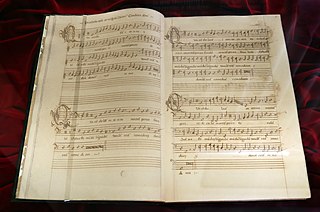Related Research Articles
Giaches de Wert was a Franco-Flemish composer of the late Renaissance, active in Italy. Intimately connected with the progressive musical center of Ferrara, he was one of the leaders in developing the style of the late Renaissance madrigal. He was one of the most influential of late sixteenth-century madrigal composers, particularly on Claudio Monteverdi, and his later music was formative on the development of music of the early Baroque era.
The year 1608 in music involved some significant events and new musical works.

Claudio Merulo was an Italian composer, publisher and organist of the late Renaissance period, most famous for his innovative keyboard music and his ensemble music composed in the Venetian polychoral style. He was born in Correggio and died in Parma. Born Claudio Merlotti, he Latinised his surname when he became famous in Venetian cultural clubs.

Hans Leo Hassler was a German composer and organist of the late Renaissance and early Baroque eras, elder brother of composer Jakob Hassler. He was born in Nuremberg and died in Frankfurt am Main.

Antonio Cifra was an Italian composer of the Roman School of the Renaissance and early Baroque eras. He was one of the significant transitional figures between the Renaissance and Baroque styles, and produced music in both idioms.

Giovanni Paolo Colonna was an Italian composer, teacher, organist and organ builder. In addition to being chapel-master and organist of San Petronio Basilica in Bologna, he served prominent members of the courts of Ferrara, Parma, Modena and Florence. He was a founder-member and president of the Accademia Filarmonica di Bologna. Emperor Leopold I collected manuscripts of his sacred music, which reflects the Roman church cantata style of Giacomo Carissimi and looks forward to the manner of George Frideric Handel.
The year 1624 in music involved some significant events.
The year 1603 in music involved some significant events.
The decade of the 1540s in music involved some significant events.

Francesco Corteccia was an Italian composer, organist, and teacher of the Renaissance. Not only was he one of the best known of the early composers of madrigals, and an important native Italian composer during a period of domination by composers from the Low Countries, but he was the most prominent musician in Florence for several decades during the reign of Cosimo I de' Medici.
This is a list of notable events in music that took place in 1554.
Benedetto Pallavicino was an Italian composer and organist of the late Renaissance. A prolific composer of madrigals, he was resident at the Gonzaga court of Mantua in the 1590s, where he was a close associate of Giaches de Wert, and a rival of his younger contemporary Claudio Monteverdi.
Ercole Pasquini was an Italian composer and organist.
Giovanni Paolo Caprioli was an Italian priest, abbate in Candiana, and composer. Caprioli-Capriolo Giovanni Paolo. Born in Brescia in 1571 ca. and here he died in the convent of St. John the Evangelist during the plague in January 1630. The noble family from Brescia Caprioli is attested in documents citizens since the eleventh century. Gentlemen from the time of Henry III of the lands of Capriolo (BS), moved into town in the early fourteenth century living in different buildings but particularly in the palace Caprioli Via Elia Capriolo. The family was the birthplace of two important musicians: Alfonso Antonio Caprioli and John Paul that in 1587 he entered the convent of Scandiano (PD) belongs to the Congregation of the Rhenish Lateran Canons of SS. Savior of Bologna. In this religious order the severity and austerity of monastic life married with a keen sensitivity to the artistic decoration of the churches and a special interest in a cultural qualification through the study. Figures of great composers and organists will require a bit 'anywhere in the various convents of the Congregation, especially in Bologna, Mantua, Venice and Brescia, where, in the rectory of St. John is the strong influence of traditional instrumental and vocal production environment Brescia Renaissance and Baroque. Among the major players operating in the convent Brescia remember Floriano Channels, Angelo Maria from Peschiera, Leone from Bologna, Dionysius from Fano, Peter Knights, Giovanni Artusi, Pietro Andrea Ziani, Carlo Maffei and not least John Paul Caprioli which we can thank the studies of Oscar Mischiati retrace his monastic pilgrimage:

The Basilika Palatina di Santa Barbara is the Palatine Chapel of the House of Gonzaga in Mantua, Italy.
References
- 1 2 Lewis, Uncle Dave. "Paul Kenyon - Costanzo Antegnati: L'Antegnata". Allmusic. Retrieved June 22, 2013.
- 1 2 Bush, Douglas Earl; Kassel, Richard (2006). The Organ: An Encyclopedia. Psychology Press. p. 33. ISBN 0415941741 . Retrieved June 22, 2013.
- ↑ Carlo Gozzi, Raccolta di documenti per la Storia di Castelgoffredo e biografia di que' principi Gonzaga che l'hanno governato personalmente, 1840
- 1 2 Pratt, Waldo Selden. The History of Music. New York: G. Schirmer, Inc., 1907. 121.
- ↑ "Costanzo Antegnati". Here of a Sunday Morning. WBAI. Retrieved June 22, 2013.
- Gli Antegnati. Studi e documenti su una stirpe di organari bresciani del Rinascimento, a cura di Oscar Mischiati, Bologna, Pàtron editore, 1995 (Biblioteca di cultura organaria e organistica, 9).
- Flavio Dassenno Bellissimi organi bresciani Provincia di Brescia, 2002